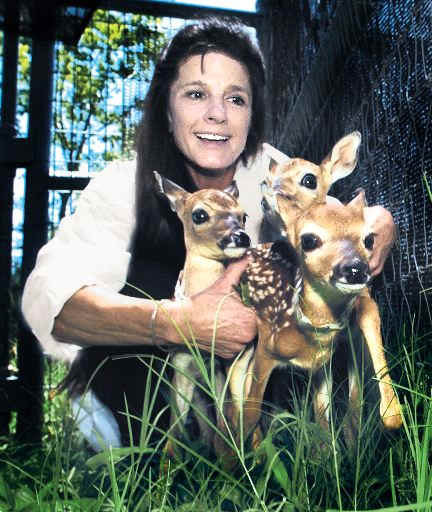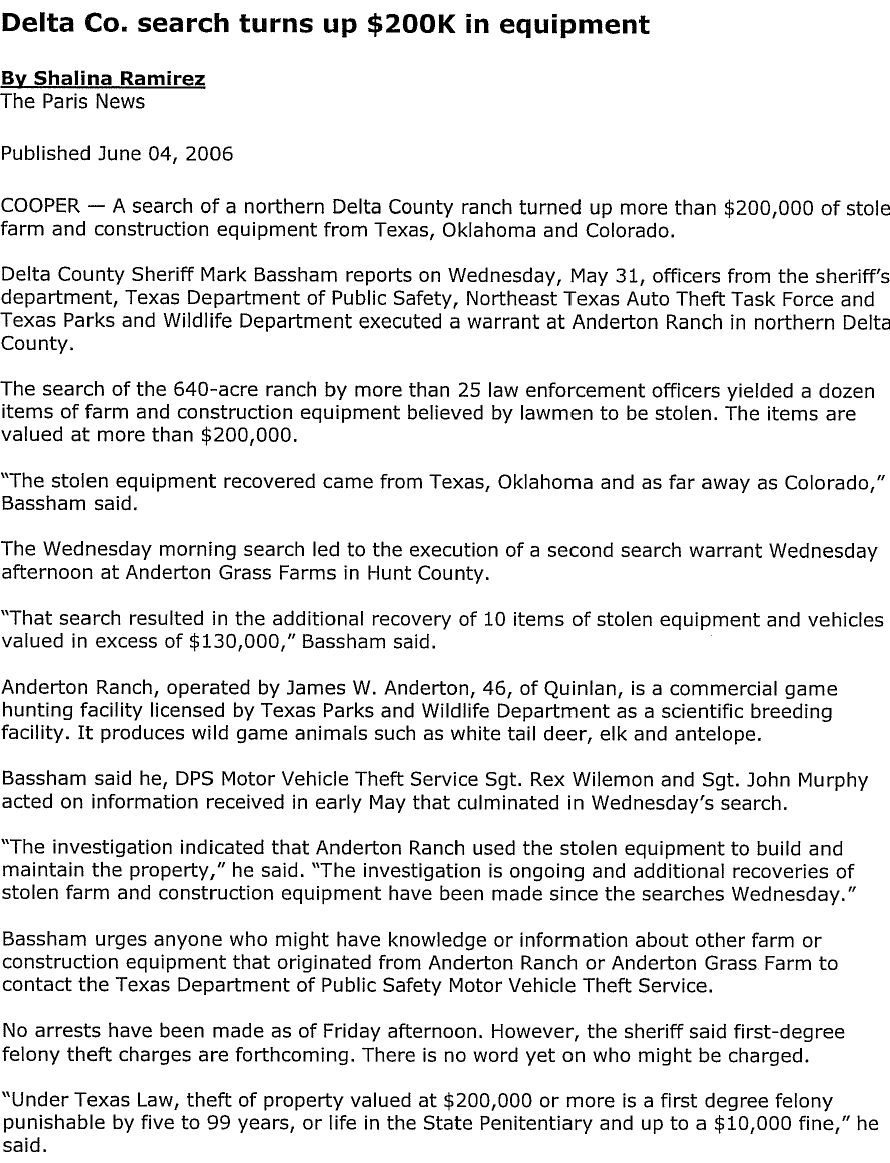Doe, a Deer, 3 Female Deer
A&M scientists marvel at trio of healthy fawns
By ARENA WELCH
Eagle Staff Writer
Texas A&M researchers recently bred Dewey, the world's
first cloned white-tailed deer, in hopes of studying whether his
large antlers would be inherited by his offspring.
 |
|
Eagle Photo/Dave McDermand
Alice Blue-McLendon of the Texas
A&M Wildlife and Exotic Center said the triplet
fawns are the offspring of a cloned father, Dewey. The
purpose of Dewey has been to study whether his large
antlers can be inherited, so the three fawns, all
females, wonÕt be much help. They are named Sandy,
Debbie and Gavi.
|
But even though his triplet fawns were born last Wednesday -
giving researchers three shots at exploration - they're going to
have to wait for the next round.
Born at the Texas A&M Wildlife and Exotic Center, Sandy,
Debbie and Gavi are happy, healthy and a little big for their
age, experts said.
And, as each name suggests, they are female.
"We'll have to see what it does in the next
generation," said Alice Blue-McLendon, who oversees their
care at the center.
Blue-McLendon said re-searchers weren't disappointed. They
will keep breeding Dewey and eventually study his sons to see if
the offspring of a clone will inherit his large antlers, just
like the offspring of a natural buck would.
Scientists now have no knowledge about antler inheritance in
the offspring of a clone, the clinical veterinarian said.
Sandy and Debbie each weighed 5 1/2 pounds at birth, while
Gavi weighed about 3 1/4 pounds.
The trio's mother, Heidi, is 10 years old. Dewey was born in
May 2003 and is the only cloned deer at the center. He was
cloned using skin tissue from a slain deer - another first,
Blue-McLendon said. The buck whose cells were used was described
as "larger than average," which makes Dewey, his
genetic equal, the ideal source of large antlers.
Since 1999, Texas A&M researchers have cloned six other
species not including Dewey. Second Chance, a bull, was born in
August 1999. A disease-resistant calf named 86 Squared was
cloned in November 2000. In 2001, three cloned species were born
- a Boer goat named Second Addition in March, a litter of
piglets in August and a cat named cc, short for carbon copy or
copy cat, in December. In March 2005, Paris Texas, the first
cloned horse in North America, was born.
Triplet fawns are rare, and the center never has had a set,
Blue-McLendon said. A doe usually will have only one fawn at a
time when she is young, and she can birth twins several years
later, she said.
"It's hard for them to raise three," she said.
"That's a lot of little mouths to feed."
The trio recently was separated from their mother and are
being "hand-raised," meaning they are fed and handled
by humans, so they will be tamer and able to handle life at the
center around people, Blue-McLendon said.
"They're still wild animals, but they're much better
suited for captivity," she said.
Texas A&M students assist the center's staff in feeding
and caring for the fawns, Blue-McLendon said.
"They're excellent teaching tools for students who are
learning to care for baby livestock," Blue-McLendon said,
adding that many students who work at the center want to be
veterinarians and zookeepers.
The triplets will remain at the center for life, Blue-McLendon
said. In the future, the fawns likely will be studied in
reproductive research, she said.
"When they're this young, we don't really know exactly
what kind of research projects they'll be used for," she
said.
• Arena Welch's e-mail address is arena.welch@ theeagle.com.
Frequently
Asked Questions
on Chronic Wasting Disease
Monitoring
The Big Game staff at TPWD put this FAQ on CWD sheet
together.
Movement Qualified Regulations (TPWD) and
Monitored Herd Program (TAHC)
Texas Parks and Wildlife Department (TPWD) has
new rules affecting movement of white-tailed
and mule deer from breeder facilities. Beginning
April 1, 2007, deer
cannot be transferred from
a scientific breeder facility
unless
the herd is “Movement Qualified.”
What is a “movement qualified” herd?
A movement qualified herd:
•
Is
certified by Texas Animal Health Commission (TAHC) as having a
CWD Monitored
Herd Status of level A or higher;
or
•
Has less
than five eligible deer mortalities occurring within the
facility since May 23,
2006;
or
•
Has CWD
test results of ‘not detected’ returned from the Texas
Veterinary Medical
Diagnostic Laboratories on a minimum of 20% of
all eligible deer mortalities occurring
within a facility since May 23, 2006, and has
had zero ‘detected’ results.
What is an eligible mortality?
An eligible mortality is any lawfully possessed
deer aged 16 months or older that has died
within the facility since May 23, 2006.
What’s the difference between being Movement
Qualified with Texas Parks & Wildlife vs.
having a status level A or higher with Texas
Animal Health Commission?
There is no difference unless you plan to
transfer deer out of state. Each state sets their
own entry requirements for moving deer into
their state. Most states require three or more
years of status in a Monitored Herd Program such
as the Texas Animal Health
Commission’s Monitored Program.
Do I have to participate in BOTH the Texas
Animal Health Commission Monitored Herd
Program and Texas Parks and Wildlife Movement
Qualified program?
NO. As of April 1, 2007, you have to be movement
qualified to move deer from your breeder
facility. To be Movement Qualified you either
have to have a level A or higher status with
Texas Animal Health Commission or have 20% or
more of your eligible deer mortalities
tested at Texas Veterinary Medical Laboratories,
or have less than five eligible mortalities.
Which program do I need to be enrolled in?
The best program should be determined by the
future goals of your breeder herd. If you
plan to transfer deer out of state, you need to
maintain level A or higher status with Texas
Animal Health Commission’s Monitored Herd
Program. For all in-state activities, the TPWD
movement qualified status will meet the needs of
deer breeders.
Texas
man saves friend during fatal chimp attack
By
CLAIRE OSBORN
Cox News Service
Thursday,
April 27, 2006
AUSTIN,
Texas — His
friend's hand was a mangled mess — most of it was gone. The
station wagon had stalled after the driver desperately tried to
ram through a gate. And now the chimpanzee that had attacked
them on an isolated mountain road in West Africa was coming at
them again.
What
was supposed to be a day of sightseeing Sunday at the Tacugama
Chimpanzee Sanctuary had turned into a moment that will forever
be seared into Gary Brown's memory.
"I
knew I was going to die, but I didn't want to die running,"
said the 51-year-old Texas man, who was working as a contractor
in Sierra Leone.
Inside
the Peugeot station wagon were Brown, two American co-workers,
Melvin Mammah, a friend Brown had met in Freetown, and Issa Kanu,
who had been driving them back and forth to work and other
places during their stay. Brown was in Africa working for a
telecommunications company at the American embassy, said
officials with Spectrum Solutions and Caddell Construction.
Brown,
who returned home Tuesday night, didn't know at the time that
more than a dozen chimps had escaped from the 100-acre sanctuary
on the outskirts of the capital of Freetown. And he didn't know
chimps would attack people. When the chimp had appeared on the
road in front of them, he had fished for his camera, eager to
get a snapshot.
But
Kanu seemed to know something was wrong and put the wagon in
reverse.
That's
when the chimp charged, Brown said.
He
said it tore off the side mirror and broke through the back
windshield. "It was like the glass wasn't even there,"
he said.
Brown,
said he's 5-foot-9 and weighs more than 200 pounds, and the
chimp probably outweighed him.
"He
had every bit two-inch fangs, and he was screaming like a
banshee . . . when he was charging us."
Mammah
fought the chimp off, but not before the chimp bit off half of
his hand, Brown said.
They
wrapped up Mammah's hand and drove forward, trying to outrun the
chimp, he said. Then they came to a steel gate. Kanu rammed it,
and the gate opened, but not enough to get the car through, he
said.
The
car stalled, its front end crumpled. Reverse didn't work, so
they got out trying to push it backward so they could turn it
around, Brown said.
"He
was charging again, coming up the road," Brown said.
"When we turned around, we all dove in the car."
Kanu
tried the key again. The wagon started, and he tried to drive
through the opening in the gate, but it became wedged into the
opening, Brown said.
The
chimp "went across the top of the car, and that's when . .
. it was just a flurry trying to get away from it. Melvin got
pulled out of the car by it."
When
he jumped out of the car, Brown said he heard Mammah screaming
for help. Everyone else in the car had fled, Brown said.
Brown
said he used to work as a telephone lineman and was used to
facing down angry dogs. He spotted a large tree limb.
"I
grabbed it and I just started to charge around the car to go
help Melvin," he said.
"I
believe it was God who got me through it, he turned my fear into
anger."
The
chimp charged him, he said, and he drove the end of the limb
into its throat, then chased it away.
Mammah
looked like he was bleeding to death but refused to allow Brown
to carry him, Brown said. He said he looked for the chimp and
spotted it in the jungle, watching him. He could hear
chimpanzees screaming all around them.
Brown
said he helped Mammah hobble down the road, where a military
patrol found them and took them to a hospital.
Later,
a van pulled up with Kanu's mangled body. Brown said he thought
the other Americans were dead too.
"I
can't get it out of my head," he said.
Mammah
lost all but two fingers on one hand, but is recovering in a
Freetown hospital. The two other Americans escaped safely to the
American Embassy.
Doug
Cress, the executive director of the Pan African Sanctuary
Alliance, said the chimps in the sanctuary are former pets that
have been abused by humans. He said the chimp that attacked
Brown's group was probably panicked because it was in unfamiliar
territory.
Chimpanzees
are five times stronger than humans and when they get upset in
the wild they uproot trees and throw rocks and "just go
insane with pent-up force," Cress said.
Authorities
are not sure which chimp attacked the men, said Cress, who is a
friend of the Tagucama Chimp Sanctuary's founder. The chimps
will be brought back to the sanctuary but will not be euthanized,
he said.
Brown,
meanwhile, is just glad to be home.
"I
just lived a nightmare," he said. "I know if I hadn't
fought, we would all be dead.
"From
what they explained to me, I became the alpha male when I
charged him," Brown said. "He wasn't expecting a
fight."
